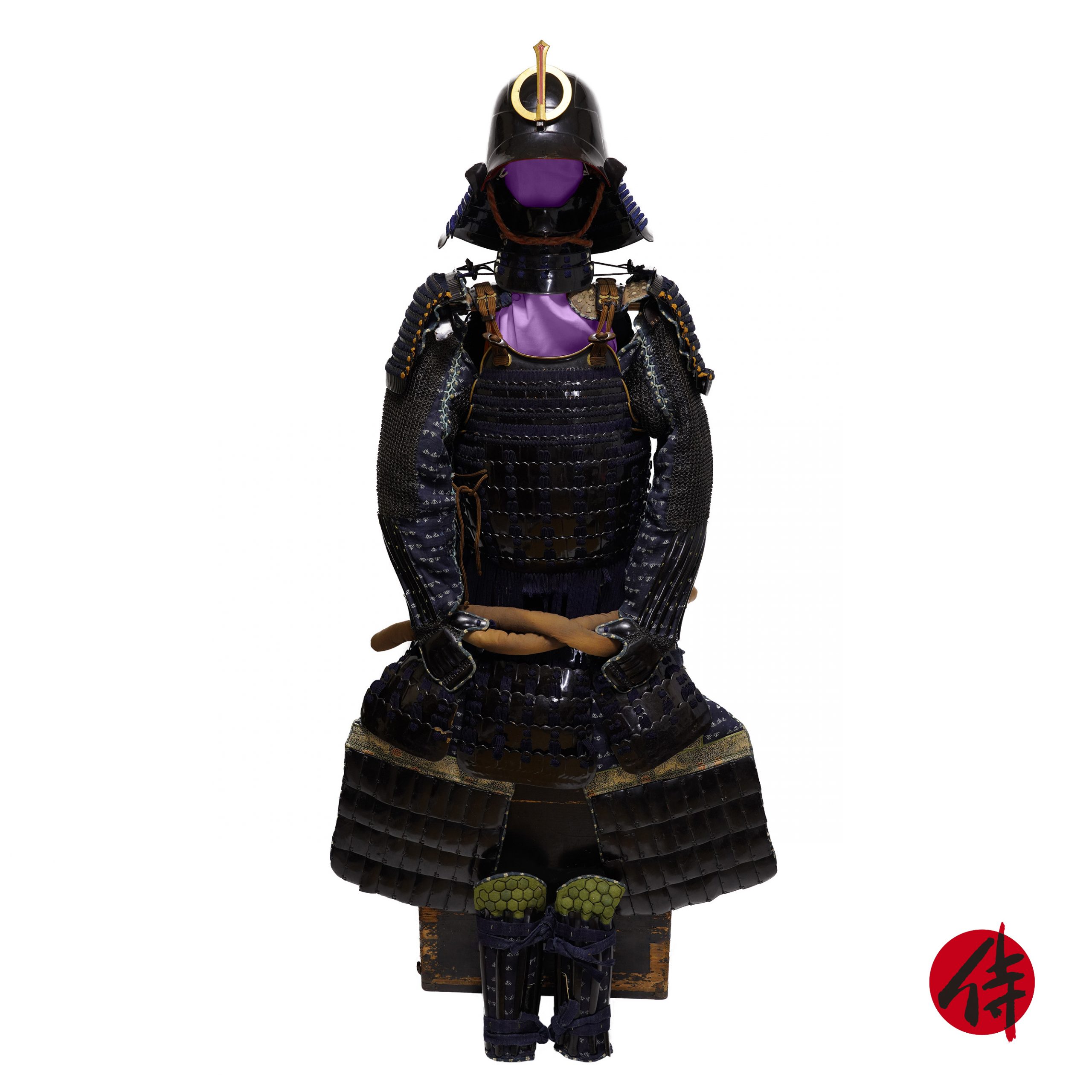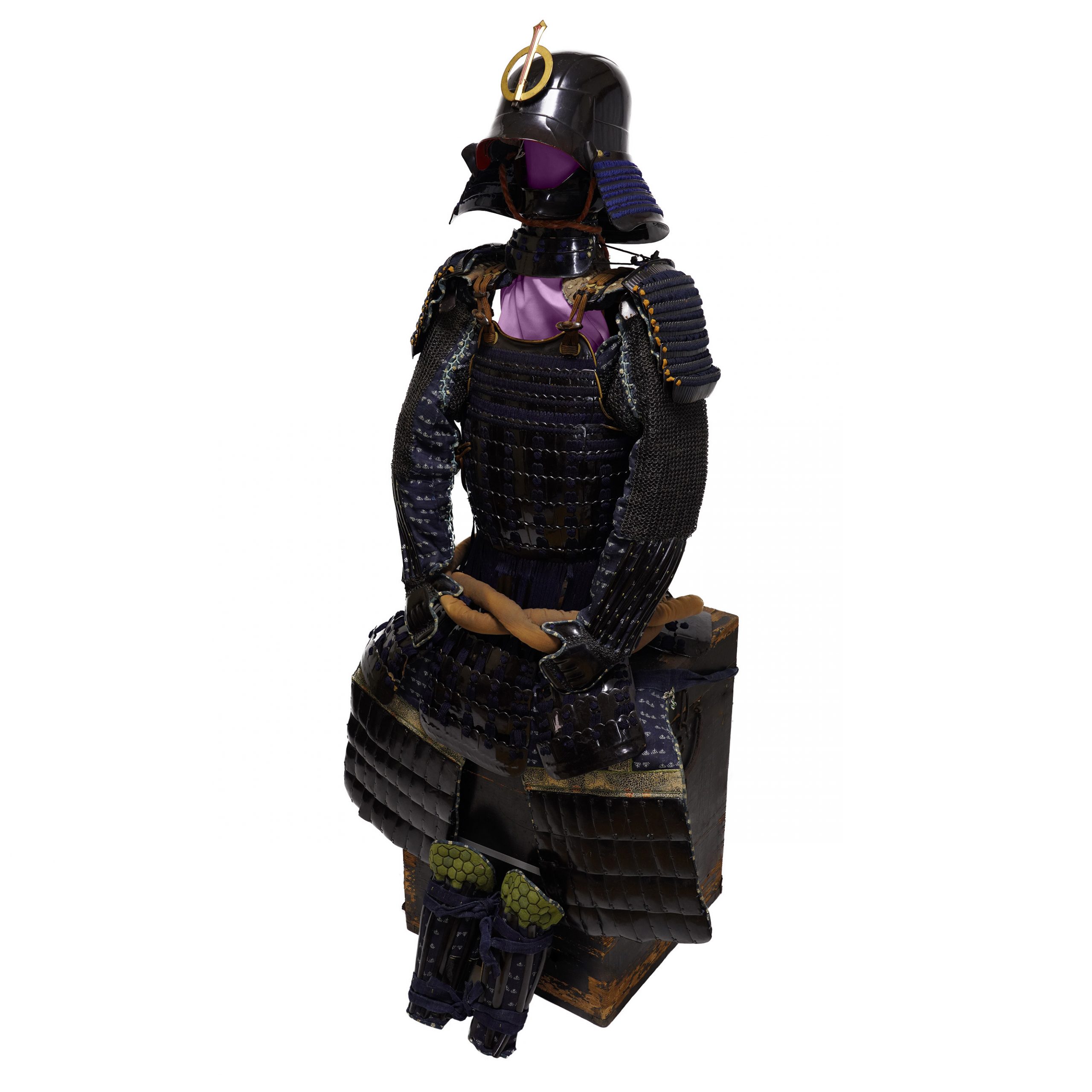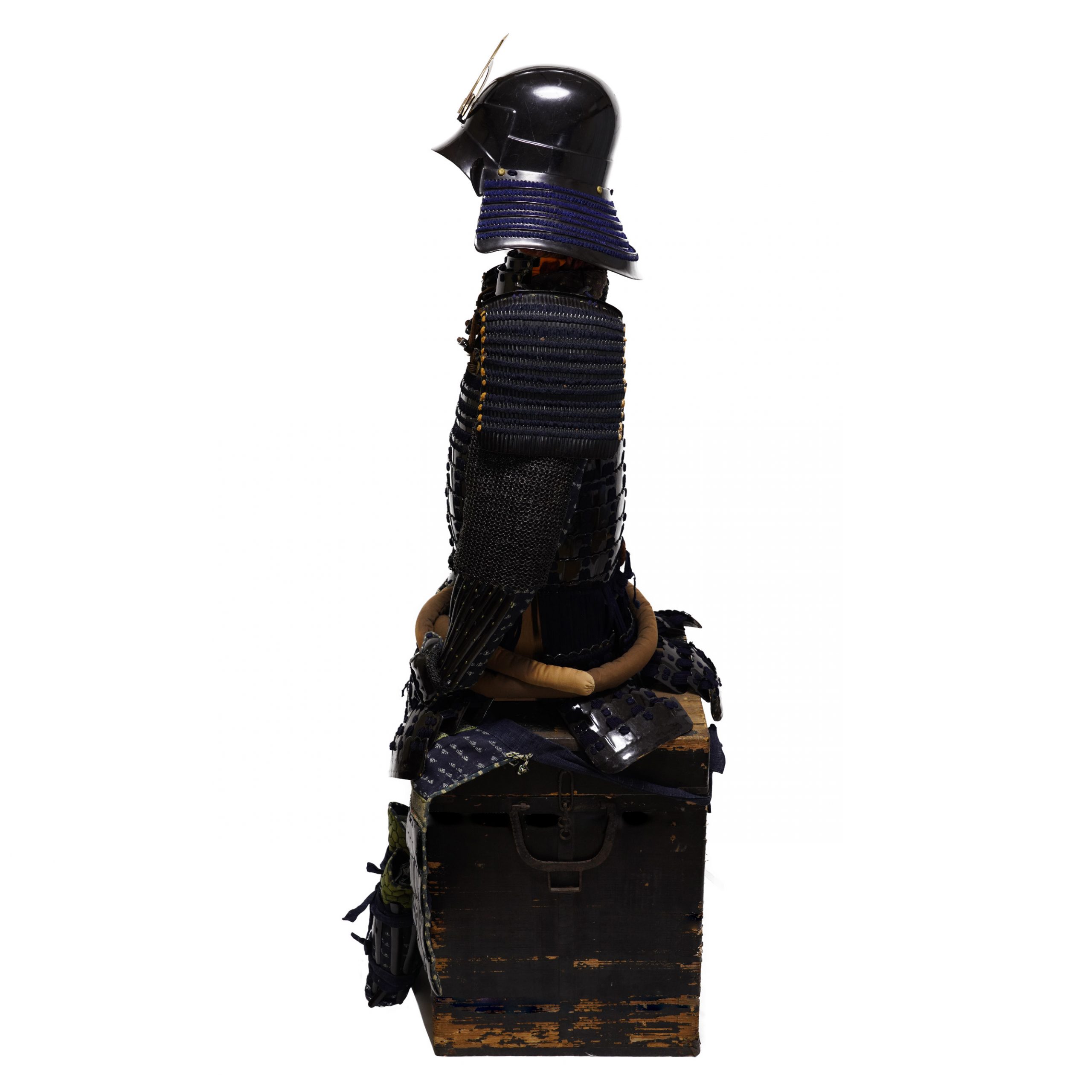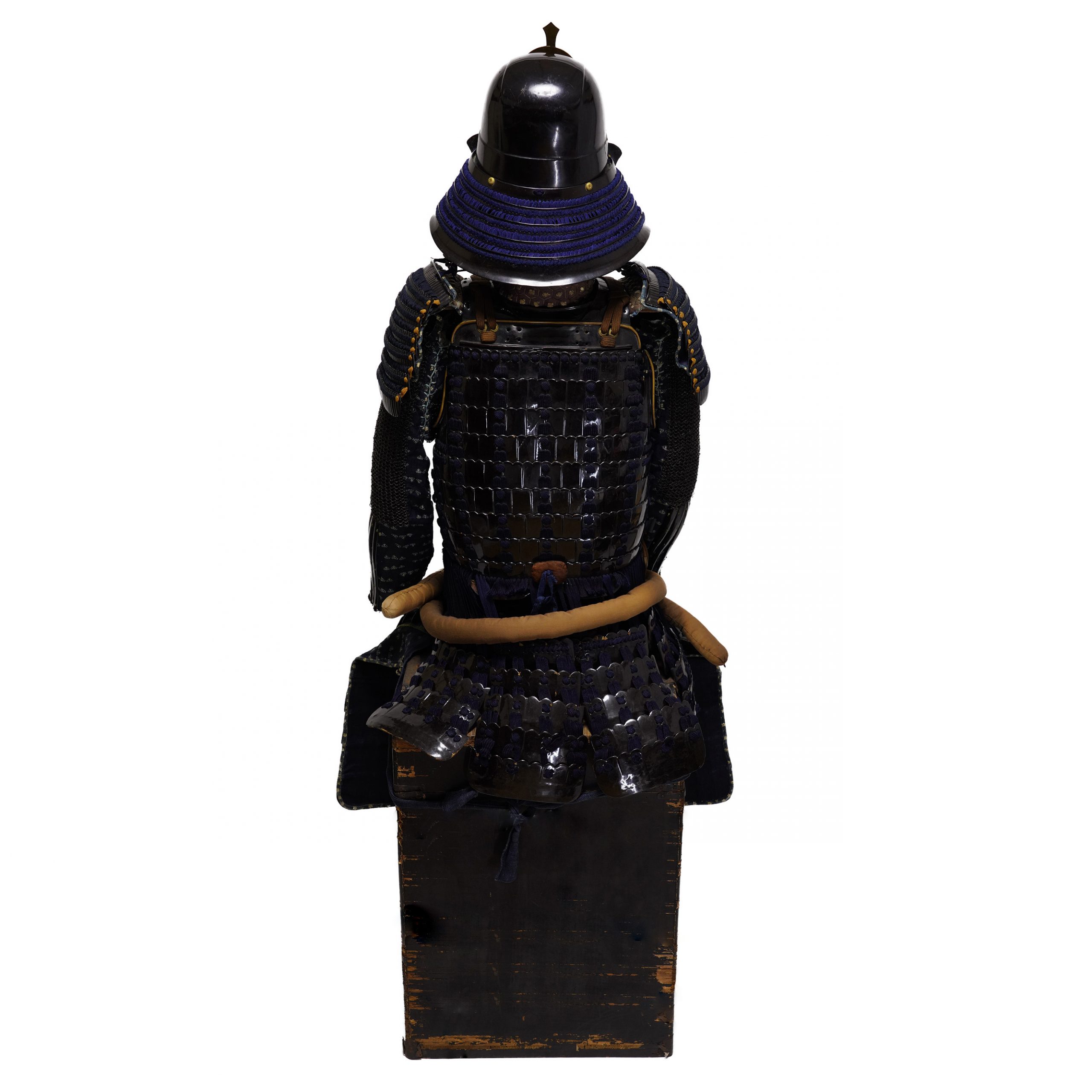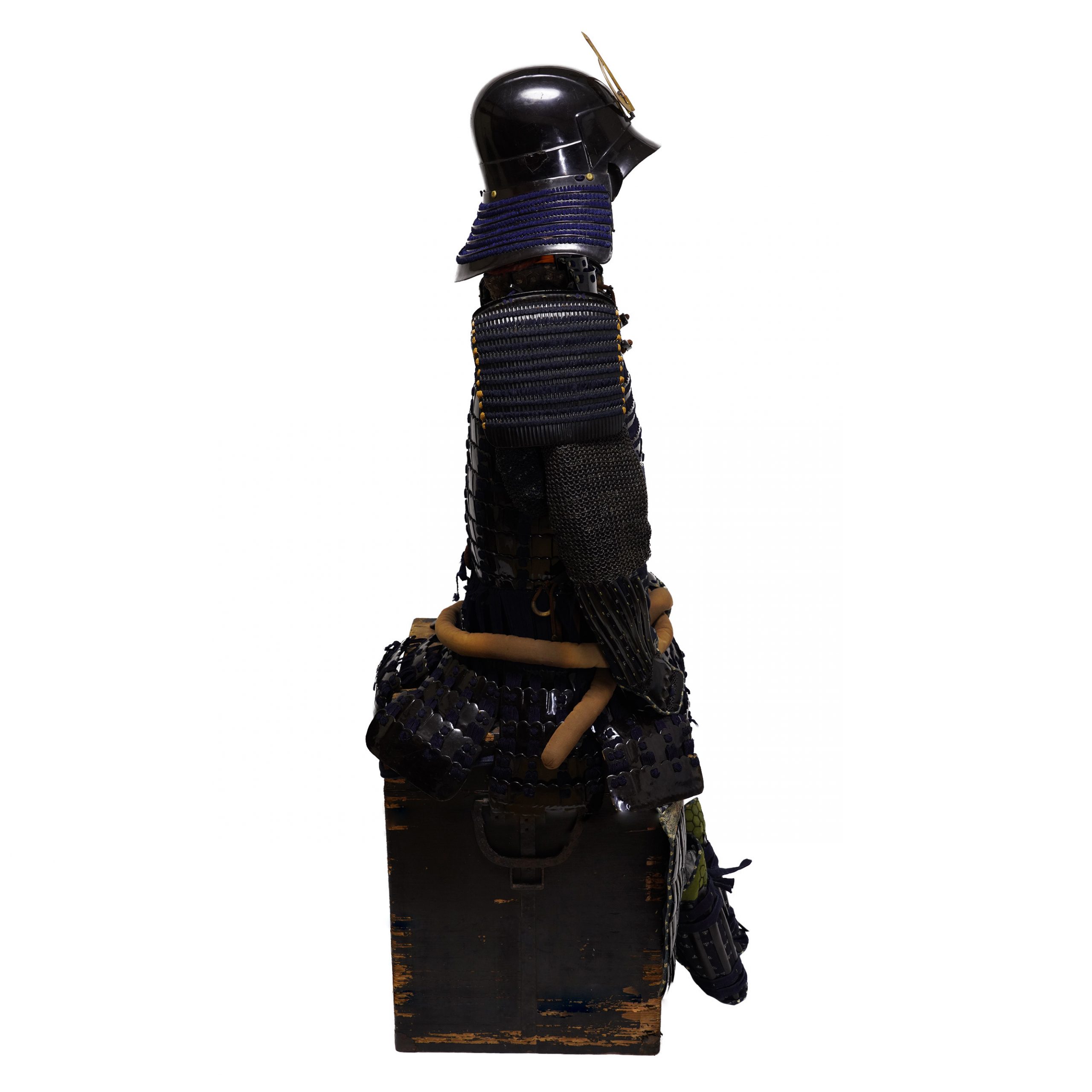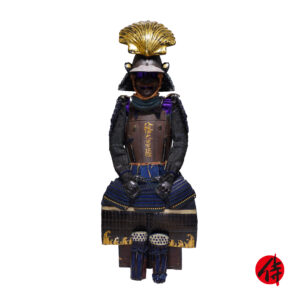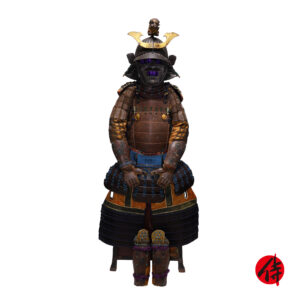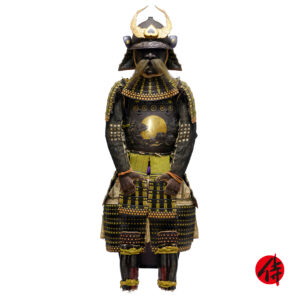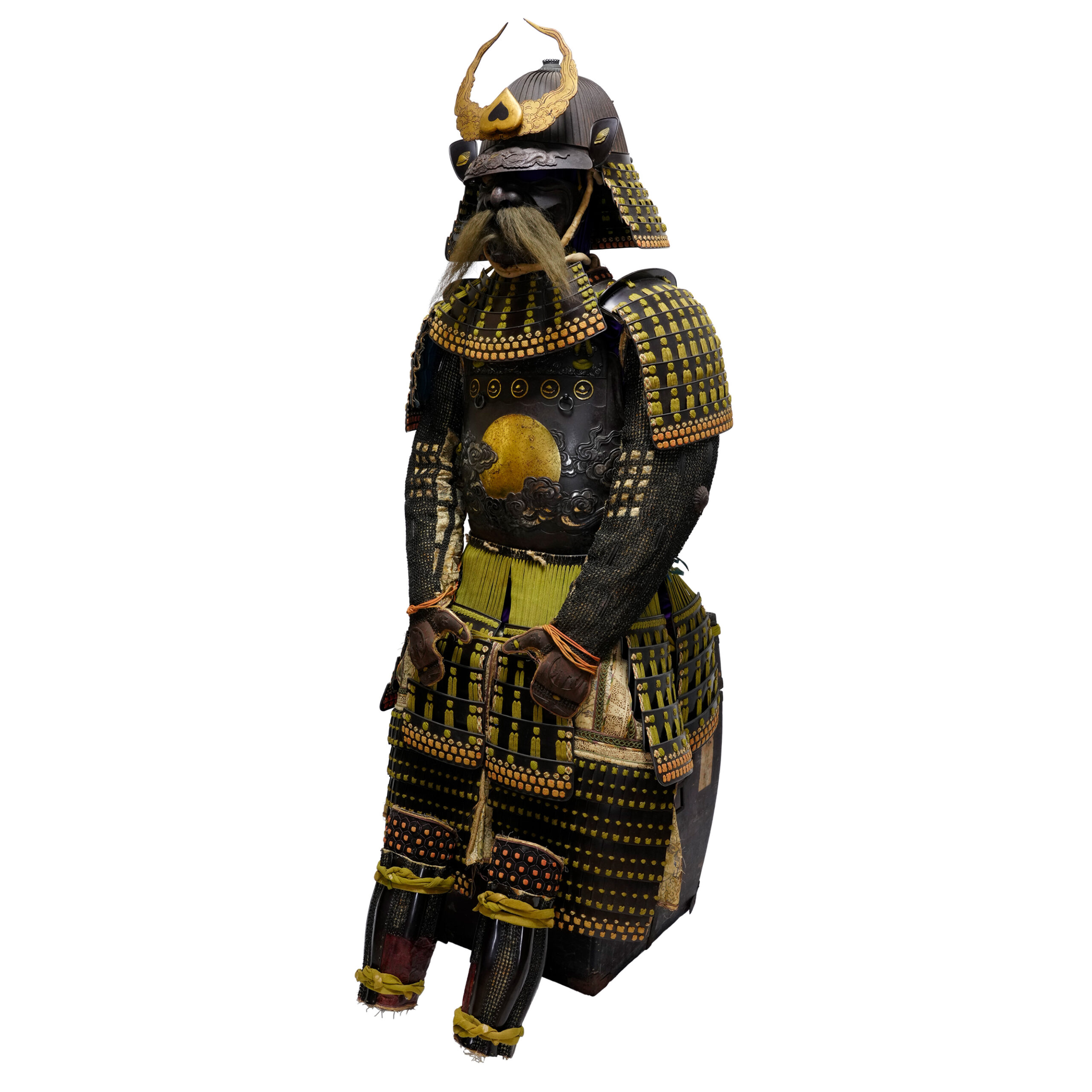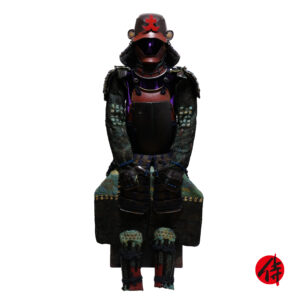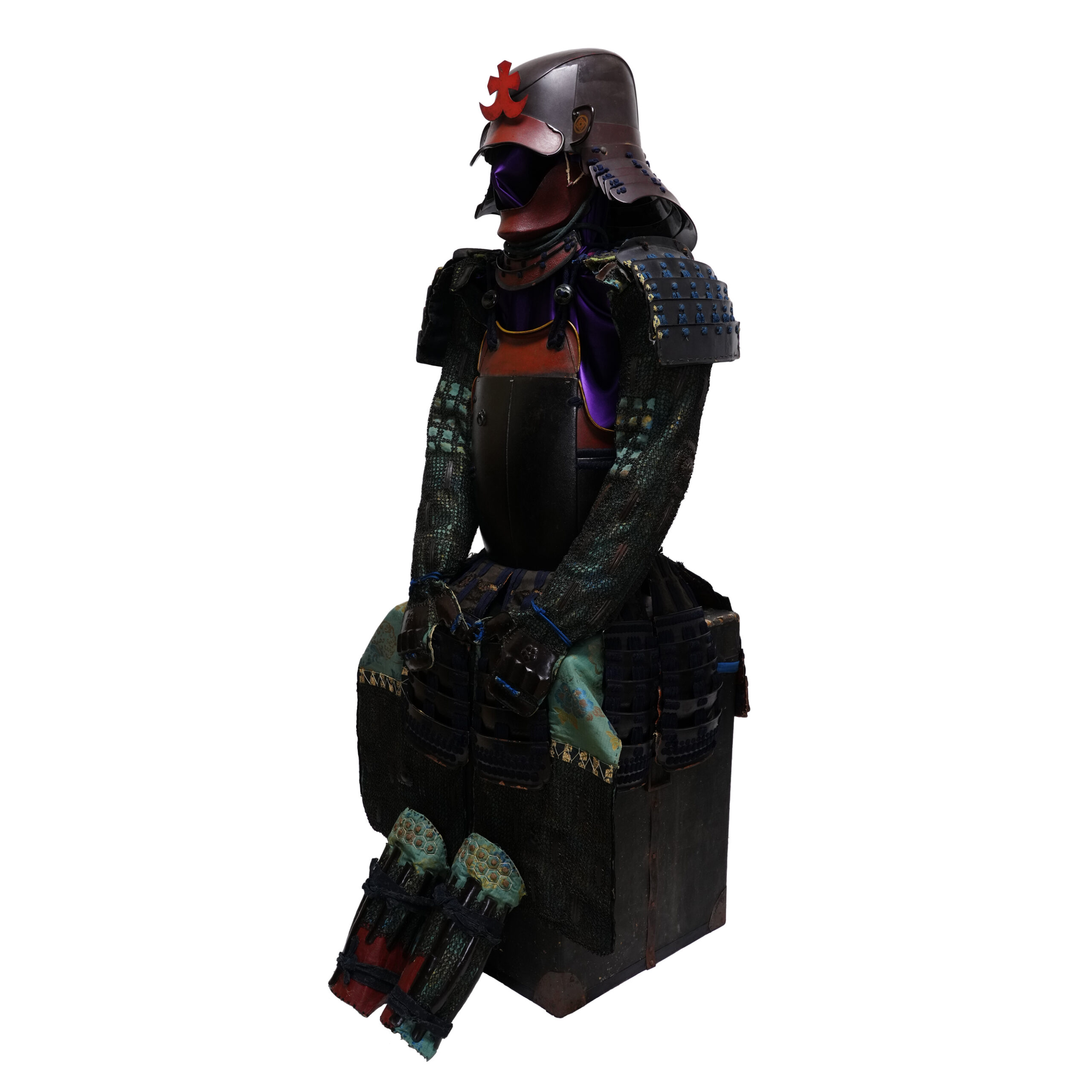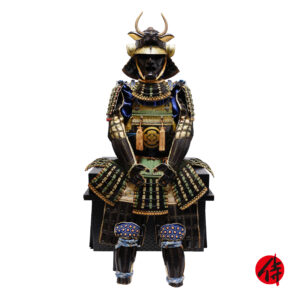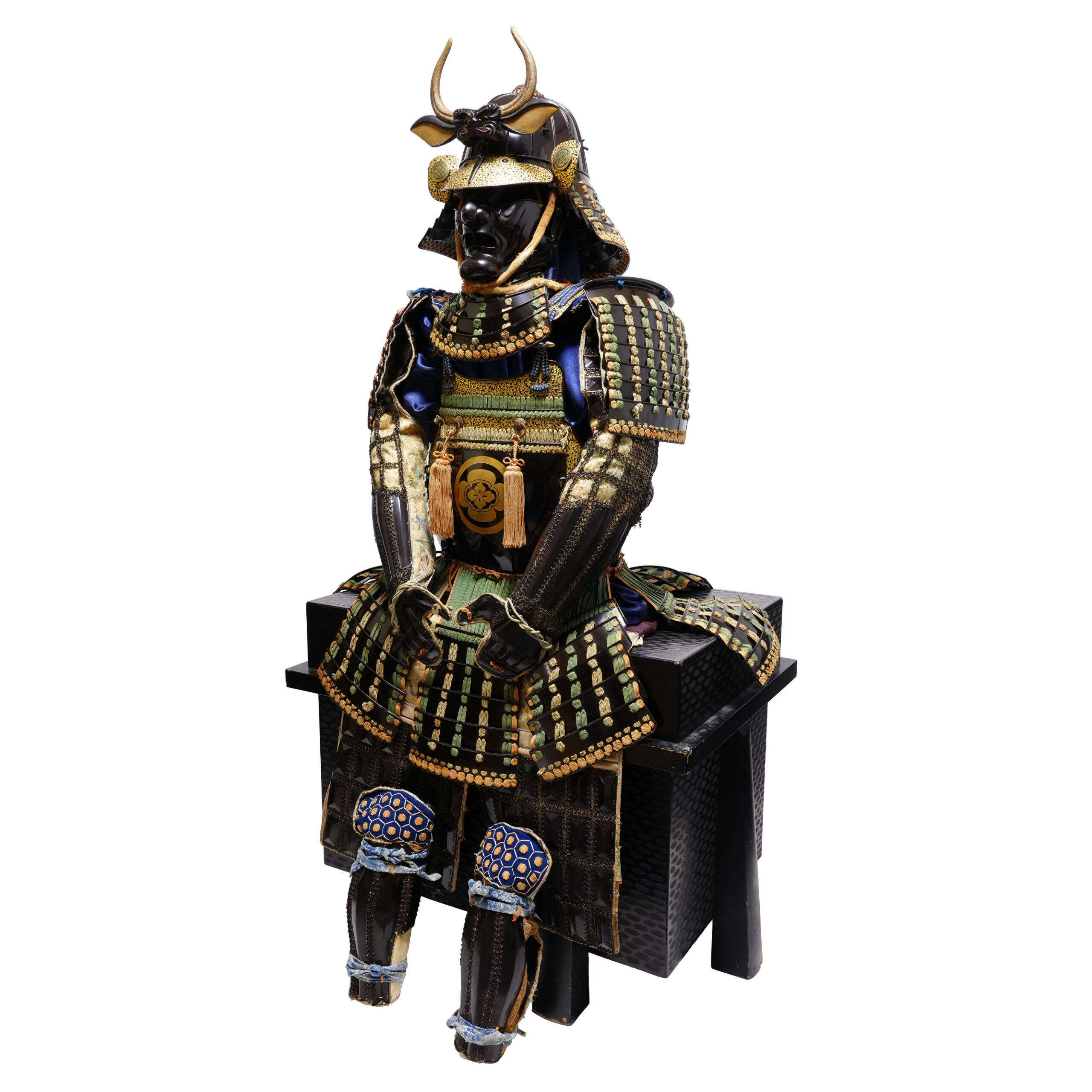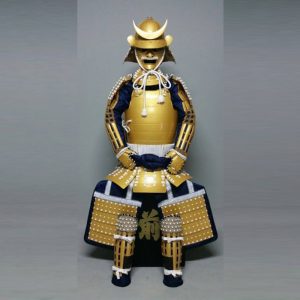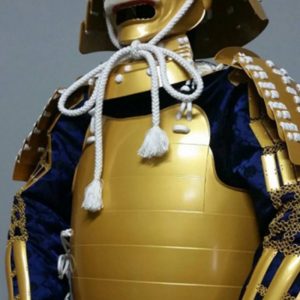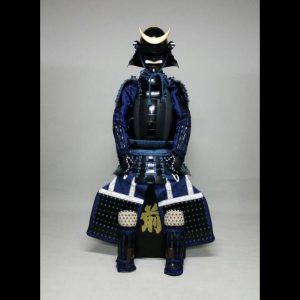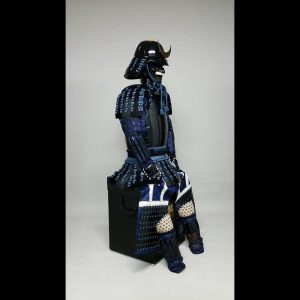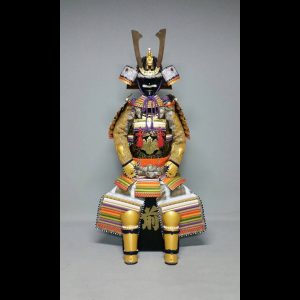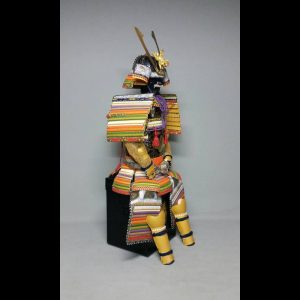Antique Iron Black Lacquered Samurai Armor (A-13)
Period: Estimated Mid-Late Edo Period
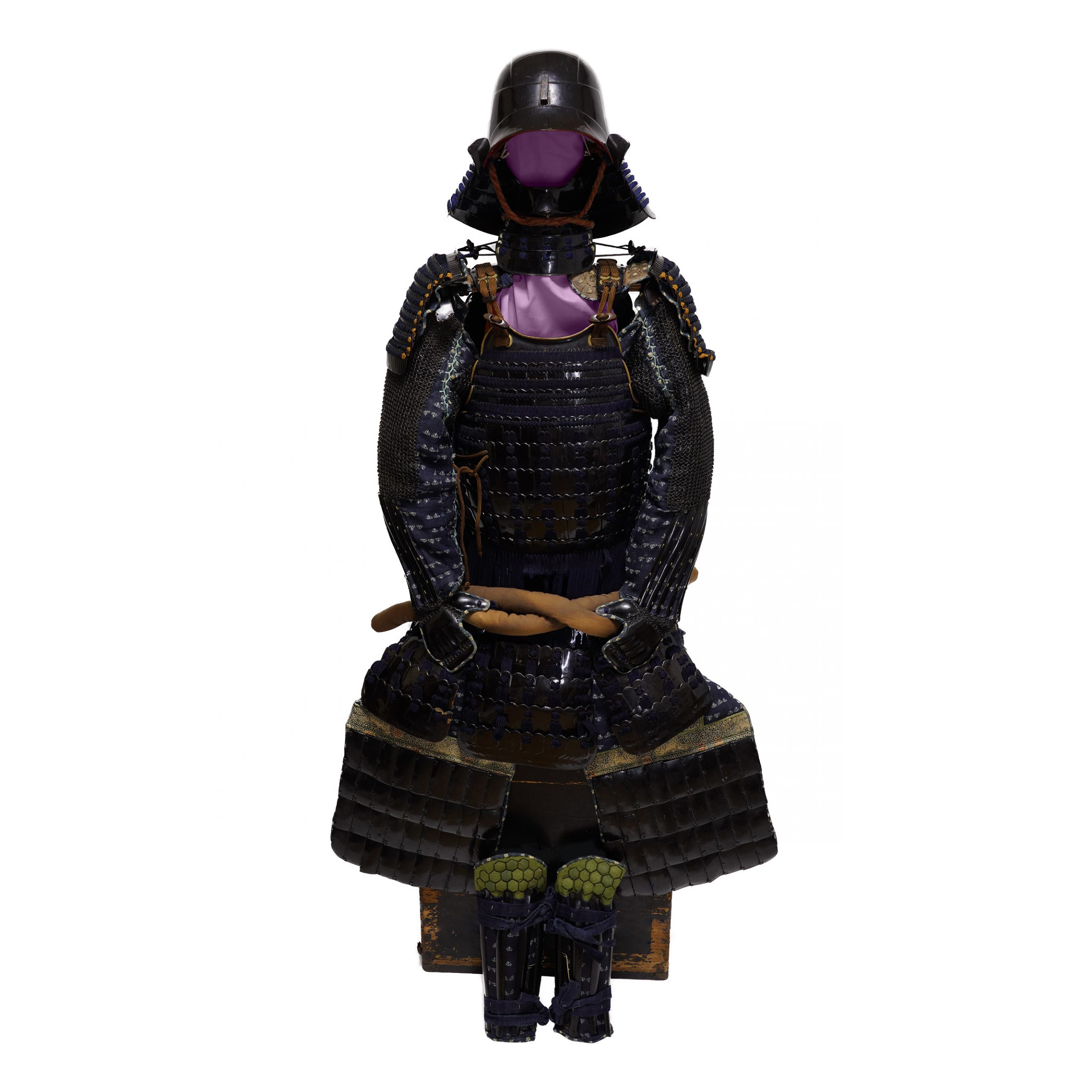
Kabuto (helmet)
■Helmet bowl:
The Kabuto (兜, helmet) is a protector for the head. When people started using the Kabuto, it was initially designed for practical use. However, the principal purpose of its design has changed with time; Samurais tried to express their dignity, personality, or religion by wearing the characteristic designed Kabutos. According to a theory, these unique designed Kabutos were made from the late Muromachi period to the Edo period. This type of Kabuto is categorized as the Kawari Kabuto (変わり兜), and a variety of materials were used to create them. For example, animal fur, seashells, plants, and papers were used as materials for decoration.
Here we would like to introduce to you a little bit more about the history of Kabutos. Before the Kawari Kabuto’s production, the Suji Kabuto (筋兜) has appeared during the Nanbokuchou (南北朝, 1337-1392) period. At that time, the tactic was gradually changed from the piggyback fight style to battle with the Tachi (太刀) sword and the Naginata (薙刀, Japanese halberd) on the ground. Therefore, there was a rise in demand for the weight saving of the Kabuto. Also, in order to turn the attack by swords, a new type of structure was invented; it is the Suji Kabuto (筋兜). Its form slides swords’ attacks when weapons hit the Kabuto. It is said that the production of the Suji Kabuto prospered in the Muromachi (室町, 1336-1573) period.
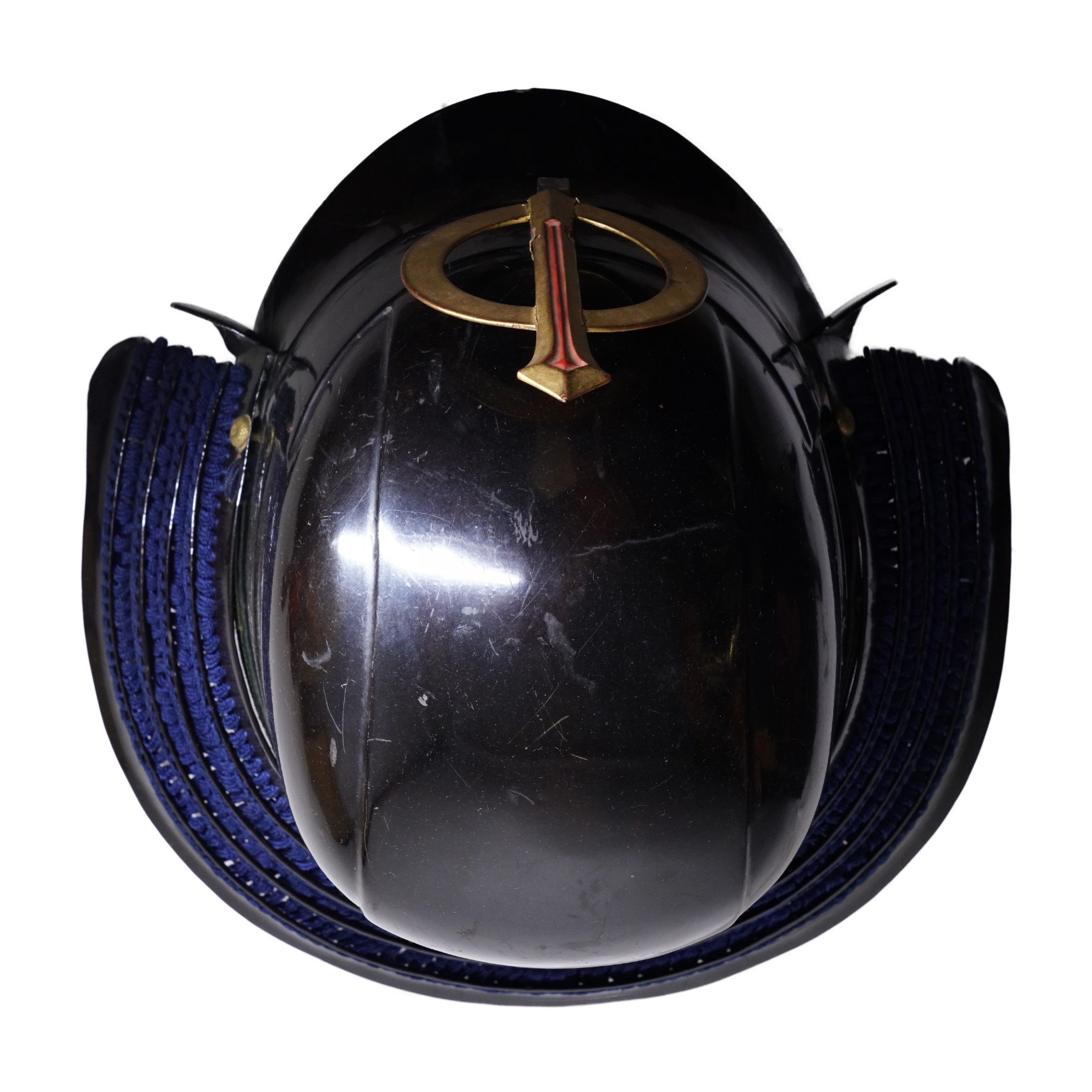
■Shikoro (side neck guard):
Iron plates laced with navy blue threads.

■Fukikaeshi (side neck guard):
The Fukikaeshi (吹き返し) is both ends of a helmet. It protects the face from swords and also shows its beautiful workmanship. This helmet’s Fukikaeshi is made of an elegant black lacquered iron plate and has a simple look. Family crests are sometimes designed on this part.

■ Maedate (Front decoration): Nichirin and sword
The Maedatemono (前立物, front decoration) is attached to this helmet. We think it is the combination of the Nichirin (日輪, another name for the sun). There was a widespread belief among Samurais; the Myouken (妙見) belief. This religion was born in India. It was mixed with the Polestar belief and was brought to Japan from the Continent. The sun, the moon, and the stars of the entire universe were the symbols of faith. The Myouken Bosatsu (妙見菩薩, 菩薩 means Bodhisattva) fulfills all wishes such as fertility of rich harvest, peace, the prosperity of the clan, healing of illness, longevity, success in business, traffic safety, academic achievement, marriage, etcetera. So, it is understandable that the sun motif was appreciated among Samurais. The former owner of this armor might have had shown his faith wearing this helmet.
Uesugi Kenshin (上杉 謙信, 1530-1578), a famous feudal Daimyo (大名, a Japanese feudal lord), who ruled the Hokuriku (北陸) area also liked this design. He fought in lots of battles and won victory in most of them. Therefore, he was called the Gunshin (軍神, god of war). His helmet had the front decoration, and its motif was the combination of the Nichirin and the crescent moon. A theory says he believed the Myouken belief and especially worshipped the sun and the moon. By combining the Nichirin and a sword, this Metate’s designer might have tried to show his faith and determination to be successful on battlefields.

Armor
■Do (cuirass): Okegawa Nimai Do
The Nimai Do (二枚胴) is a kind of cuirass for Tousei Gusoku (当世具足, developed armor style). Since Nimai (二枚) means two plates, and Do (胴) means torso in Japanese, this type of Do is called this name. This Do uses many small lamellar plates called Kozane (小札, small strip-shaped plate).
The name Okegawa (桶側) came from the fact that the shape of this cuirass resembles the side (Gawa in Japanese) of Oke (Japanese wooden tub). The body armor part can be separated into two pieces and connected with a hinge. Typically, the hinge is located on the left side, and you can tighten this cuirass on the right side. This Do is made of black lacquered iron plates, and these were laced with navy blue thread.
■Sode (shoulder guards):
Iron Sode laced with navy blue threads.

■Kusazuri (skirt of plates attached to the cuirass):
Lacquered iron Kusazuri laced with navy blue threads.
*Please keep in mind that some of the thread aren’t connected to plates due to the aging of the silk. If you don’t mind waiting, we will be happy to have these part refurbished. For details, please feel free to contact us.
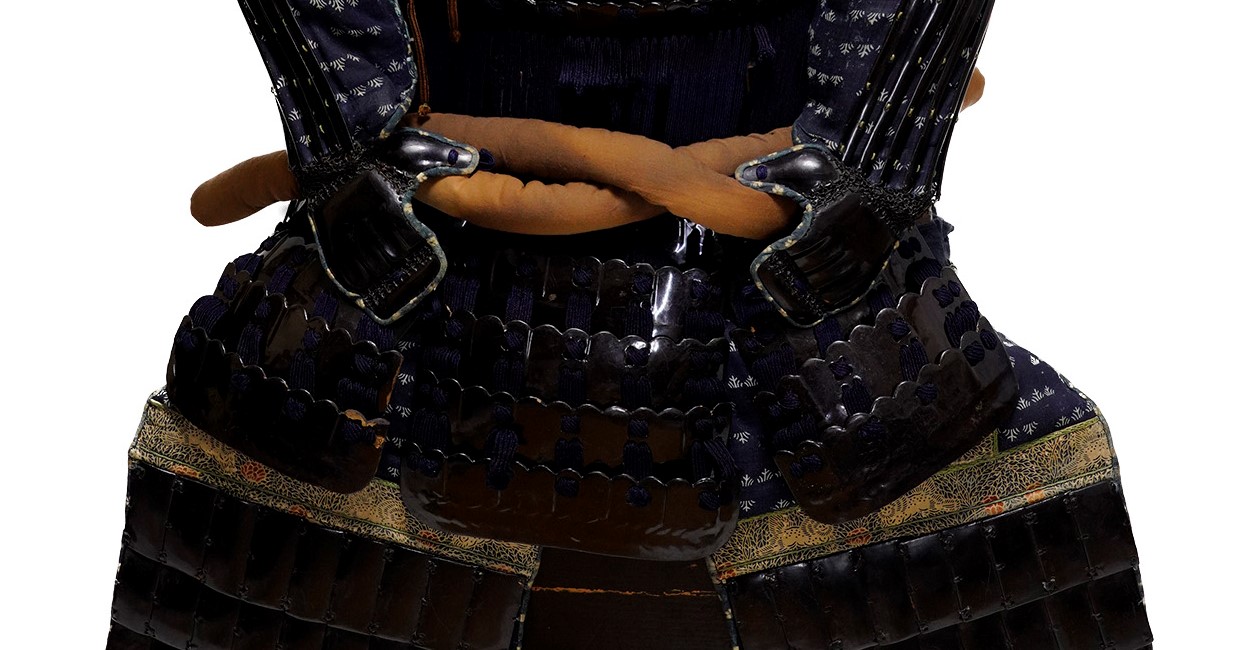
Small parts
■Kote (armored sleeves):
Intricate iron chain mail with silk.


■Haidate (thigh protection):
The Haidate (佩楯) is a thigh guard.

■Suneate (shin guard):
Lacquered iron Shin guard. The Kikkou (亀甲, turtle’s shell) pattern is used for the cloth of the leg guard. It is a continuous geometric pattern connecting regular hexagons up and down. A theory says that this design was brought from the Continent during the Asuka (592-710) and Nara (710-794) periods. A proverb says turtles live long lives; therefore, turtle and turtle’s shell pattern represent longevity. In addition, as this continuous hexagonal pattern does not get out of its shape, it is said that people wished for eternal prosperity by using this design.

【About us】
Samurai Museum is located in Tokyo, Japan, exhibiting antique artifacts related to the Samurai history. Samurai Museum Shop is the place for those who are interested in Japanese culture and craftsmanship. We deal with antique Samurai swords/armor, traditional crafts made in Japan and so on.
【Payment method】
We accept payment through Stripe (Credit card), PayPal, Apple Pay or ChromePay, all of which are secure payment methods. Also, you don’t need to make an account on Stripe for the checkout. If you prefer other payment method, please contact us. You may either pay in JPY, USD, AUD, CAD, EUR, CHF or GBP. The price is set in Japanese Yen. Prices in other currencies are automatically calculated based on the latest exchange rate.

【Shipping duration】
We normally ship via EMS (Express Mail Service) provided by Japan Post. It usually takes at least 5-14 days to deliver the package after you place an order. We offer Free International Shipping as long as we can ship your order by EMS. If you prefer other shipping carriers, please contact us.
We will inform you of the order’s tracking number via email. Please make sure you fill out your valid email address correctly.
*Please keep in mind that due to the spread of COVID-19, there might be possible delays in delivery. If you like to make sure if EMS shipping is available to your country, please contact us.

【How to make sure the condition】
Please keep in mind that what you are going to purchase is an antique item. We uploaded high resolution photos for you to check its condition thoroughly. If you like to see more photos with different angles, please feel free to contact us. We will be happy to send them to you so that you can make informed decision. It is essential for us to know that you are happy with your choice of a sword. and we are prepared to use the best of our ability to serve you.
【How To Contact Us】
Please contact us through email, Facebook Messenger or Live Chat if you have any questions. You can find each icon on the right side of the website. Please click one of them to reach us. We will reply to you within 1-2 business days.
【How To Preserve Antique Samurai Armor】
Dryness, humidity, and bad ventilation might deteriorate the condition of antique Samurai armor. The best temperature to preserve Samurai armor is around 20℃ in Celsius, and humidity should be about 60%. Direct sunlight should be avoided. We recommend storing armors in a room with good ventilation. If you like to display them outside the boxes for a prolonged time, we suggest using a glass case in order for dust not to be accumulated easily. In case you don’t use a glass case, please make sure to regularly dust off from the armor by using a soft brush made of delicate cloth or brush for painting.
If you like to know more about the preservation of this armor, please feel free to contact us.
